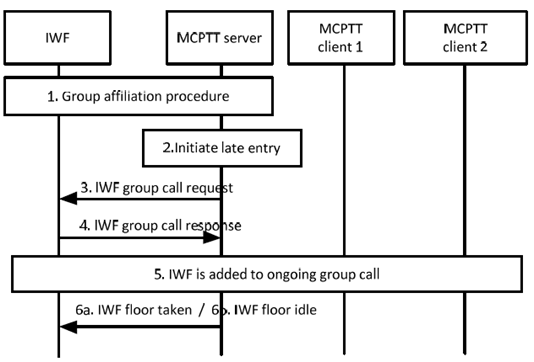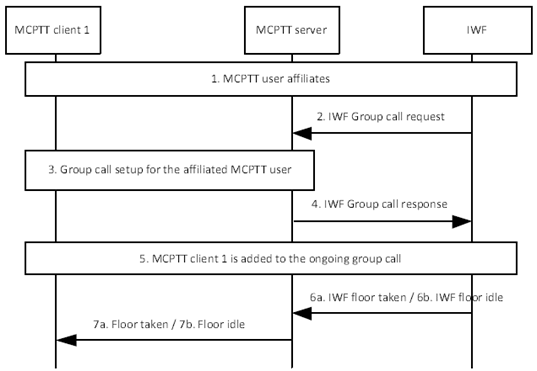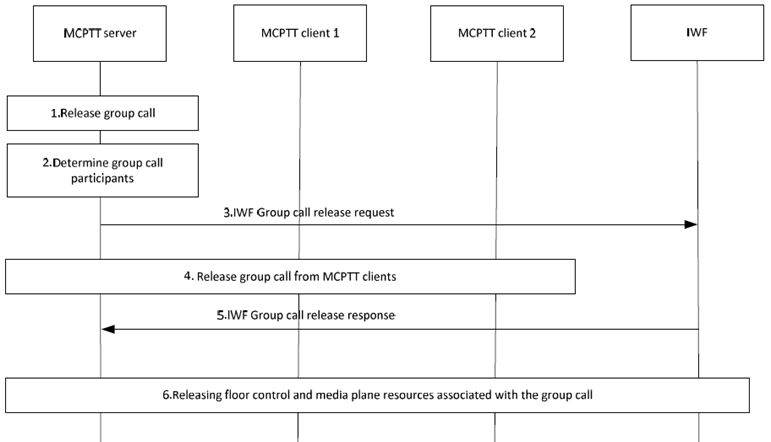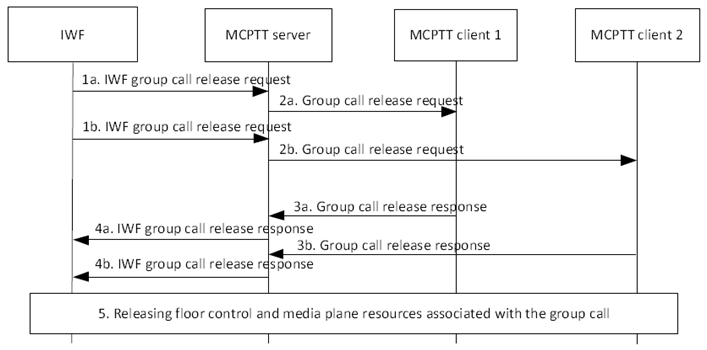Content for TS 23.283 Word version: 18.1.0
1…
10…
10.2…
10.2.2…
10.2.3…
10.3…
10.3.3…
10.3.3.7…
10.3.4…
10.3.4.4…
10.3.5…
10.3.5.8…
10.3.6…
10.3.7…
10.3.7.5…
10.3.8…
10.4…
10.4.4…
10.5…
10.5.7…
10.6…
10.6.2…
10.6.2.3…
10.6.3…
10.6.4…
10.7…
10.8…
10.11…
10.11.4…
10.12…
10.14…
10.15…
10.3.3.7 Late Entry
10.3.3.7.1 General
10.3.3.7.2 Group call late entry on an interworking group defined in the MCPTT system
10.3.3.7.3 Group call late entry on an interworking group defined in the LMR system
10.3.3.8 Interworking group call release
10.3.3.8.1 General
10.3.3.8.2 Group call release on an interworking group defined in the MCPTT system
10.3.3.8.3 Group call release on an interworking group defined in the LMR system
...
...
10.3.3.7 Late Entry p. 48
10.3.3.7.1 General p. 48
Late Entry for an ongoing interworking group call is triggered by a successful group affiliation procedure from the participating system.
10.3.3.7.2 Group call late entry on an interworking group defined in the MCPTT system p. 48
In this procedure, the group affiliation from IWF triggers a late entry procedure in the MCPTT system. The signalling procedure is described in Figure 10.3.3.7.2-1.
For the first affiliating LMR user, this procedure is applicable for both IWF affiliation options (see subclause 10.1.2.1 and subclause 10.3.1). For the following LMR users affiliating to the same group, this procedure is triggered only if the IWF passes through individual affiliations for each group member.
This subclause is based upon subclauses in TS 23.379 for:
- Late entry for pre-arranged group call, subclause 10.6.2.3.1.1.4 in TS 23.379, and
- Group call for an MCPTT group defined in partner MCPTT system, subclause 10.6.2.4.3.1 in TS 23.379.
- The interworking group information is known at the MCPTT server and the IWF by configuration or group creation. The interworking group has been defined in the MCPTT system.
- The mapping relationship of group and user identities between the MCPTT system and the LMR system has been configured at the IWF.
- There is an on-going group call in the interworking group involving MCPTT clients 1 and 2.
- First LMR user affiliates to the interworking group.

Figure 10.3.3.7.2-1: Group call late entry on an interworking group defined in the MCPTT system
(⇒ copy of original 3GPP image)
(⇒ copy of original 3GPP image)
Step 1.
The IWF triggers a group affiliation towards the MCPTT server (see subclause 10.1.2.2).
Step 2.
The MCPTT server initiates a group call late entry for an interworking group.
Step 3.
The MCPTT server sends an IWF group call request to the IWF.
Step 4.
The IWF confirms the group call request by sending IWF group call response to the MCPTT server.
Step 5.
The IWF (and the LMR user) is successfully added to the ongoing group call and MCPTT users at MCPTT client 1 and MCPTT client 2 may be notified about the LMR user joining the group call.
Step 6.
If the floor has been granted to another user, the MCPTT server sends a IWF floor taken (6a) to the IWF. If the floor is not granted to any party, an IWF floor idle (6b) is sent to the IWF.
10.3.3.7.3 Group call late entry on an interworking group defined in the LMR system p. 49
In this procedure, the group affiliation from MCPTT system triggers a late entry procedure in the LMR system. The signalling procedure is described in Figure 10.3.3.7.3-1.
This procedure describes the affiliation and late entry of the first MCPTT user into the interworking group, but it is applicable also for all subsequent MCPTT users' affiliations to the same group.
This subclause is based upon subclauses in TS 23.379 for:
- Late entry pre-arranged group call, subclause 10.6.2.3.1.1.4 in TS 23.379, and
- Group call setup involving groups from multiple MCPTT systems, subclause 10.6.2.4.1.1 in TS 23.379.
- The interworking group information is known at the MCPTT server and the IWF by configuration or group creation. The interworking group has been defined in the LMR system.
- The mapping relationship of group and user identities between the MCPTT system and the LMR system has been configured at the IWF.
- There is an on-going group call in the interworking group, involving only LMR users.

Figure 10.3.3.7.3-1: Group call late entry on an interworking group defined in the LMR system
(⇒ copy of original 3GPP image)
(⇒ copy of original 3GPP image)
Step 1.
MCPTT user (client 1) affiliates to the group (see subclause 10.1.2.4).
Step 2.
The IWF sends an IWF group call request to the MCPTT server.
Step 3.
The MCPTT server triggers a group call setup procedure for the newly affiliated user in MCPTT client 1, as described in TS 23.379.
Step 4.
The MCPTT server confirms the successful establishment of the group call by sending IWF group call response to the IWF. If E2EE is specified, then the MCPTT users and the LMR users shall use the same codec. If E2EE is not specified, the MCPTT users and the LMR users can use different codecs and transcoding is needed at the IWF.
Step 5.
MCPTT client 1 is successfully added to the ongoing group call.
Step 6.
If the floor has been granted to another user, the IWF sends an IWF floor taken (6a) to the MCPTT server. If the floor is not granted to any party, an IWF floor idle (6b) is sent.
Step 7.
The MCPTT server sends Floor taken (7a) or Floor idle (7b) to the newly affiliated user in MCPTT client 1, as described in TS 23.379.
10.3.3.8 Interworking group call release p. 51
10.3.3.8.1 General p. 51
The procedures in this subclause define the cases where the group host server releases an ongoing interworking group call for all the participants of that group.
If the group host server is an MCPTT server, the release conditions are described in subclause 10.6.2.4.1.2 of TS 23.379.
If the group host server is an LMR system, represented by an IWF, the release conditions are outside the scope of the present document.
10.3.3.8.2 Group call release on an interworking group defined in the MCPTT system p. 51
In this procedure, the MCPTT system is releasing a group call on an interworking group defined in the MCPTT system. The signalling procedure is described in Figure 10.3.3.8.2-1.
This subclause is based upon Group call release: subclause 10.6.2.4.1.2 in TS 23.379.
Pre-conditions:
- The interworking group information is known at the MCPTT server and the IWF by configuration or group creation. The interworking group has been defined in the MCPTT system.
- The mapping relationship of group and user identities between the MCPTT system and the LMR system has been configured at the IWF.
- There is an on-going group call involving the IWF and MCPTT clients 1 and 2.

Figure 10.3.3.8.2-1: Group call release initiated by MCPTT system on an interworking group
(⇒ copy of original 3GPP image)
(⇒ copy of original 3GPP image)
Step 1.
The MCPTT server initiates a group call release on an interworking group.
Step 2.
The MCPTT server identifies the participants of the ongoing group call, at least one of them being an LMR user, represented by an IWF.
Step 3.
The MCPTT server sends IWF group call release request(s) to the IWF. If the IWF has affiliated to this group on behalf of the group's LMR users, only one IWF group call release request message is sent to the IWF. If the MCPTT server has received individual affiliations from the group's LMR users, an individual IWF group call release request is sent (to the IWF) for each affiliated LMR user.
Step 4.
The MCPTT server sends the (MCPTT) group call release request(s) to the group's MCPTT users, as described in TS 23.379.
Step 5.
The IWF confirms the IWF group call release request(s) received in step 3 by IWF group call release response(s) to the MCPTT server.
Step 6.
The MCPTT client 1, client 2 and the IWF have successfully released the floor control and media plane resources associated with the group call that is released.
10.3.3.8.3 Group call release on an interworking group defined in the LMR system p. 52
In this procedure, the LMR system is releasing a group call on an interworking group defined in the LMR system. The signalling procedure is described in Figure 10.3.3.8.3-1.
This subclause is based upon Group call release, subclause 10.6.2.4.1.2 in TS 23.379.
Pre-conditions:
- The interworking group information is known at the MCPTT server and the IWF by configuration or group creation. The interworking group has been defined in the LMR system.
- The mapping relationship of group and user identities between the MCPTT system and the LMR system has been configured at the IWF.
- There is an on-going group call involving the IWF and MCPTT clients 1 and 2.
- The LMR system initiates release of the group call.

Figure 10.3.3.8.3-1: Group call release initiated by LMR system on an interworking group defined in the LMR system
(⇒ copy of original 3GPP image)
(⇒ copy of original 3GPP image)
Step 1.
The IWF sends IWF group call release requests to the MCPTT server. An individual IWF group call release request is sent for each MCPTT user in the call.
Step 2.
The MCPTT server forwards the release requests to the group's MCPTT users (in this example to users in MCPTT clients 1 and 2), as described in TS 23.379.
Step 3.
The MCPTT clients respond with group call release response(s).
Step 4.
The MCPTT server confirms the IWF group call release requests received in step 1 by IWF group call release responses to the IWF.
Step 5.
The MCPTT client 1, client 2 and the IWF have successfully released the floor control and media plane resources associated with the group call that is released.